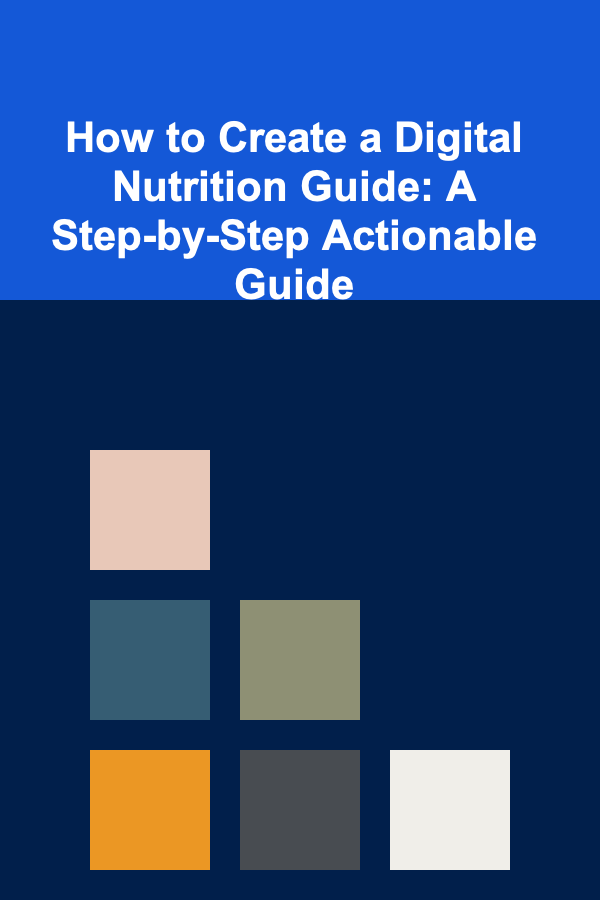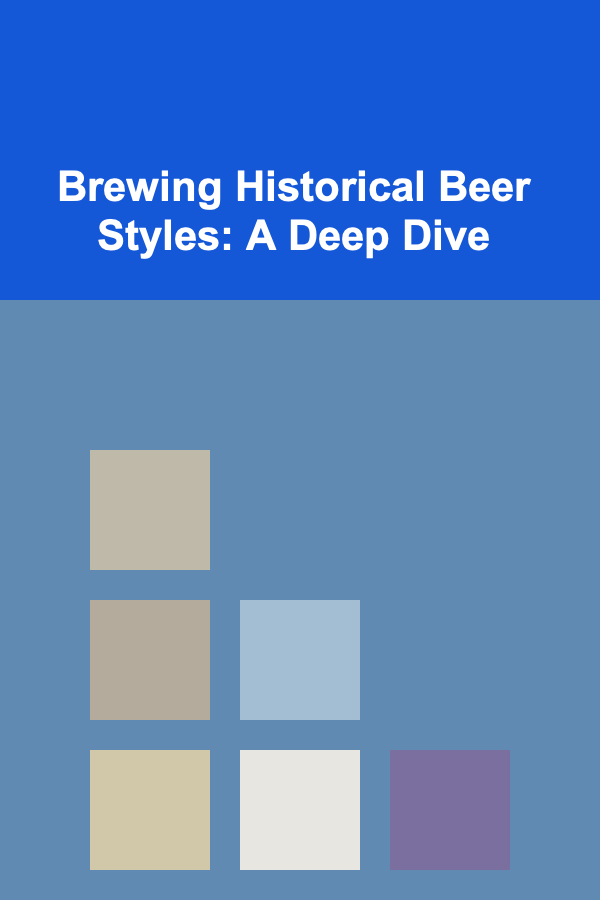
How to Create a Digital Nutrition Guide: A Step-by-Step Actionable Guide
ebook include PDF & Audio bundle (Micro Guide)
$12.99$6.99
Limited Time Offer! Order within the next:

Creating a digital nutrition guide can be an incredibly valuable resource for anyone interested in improving their health, whether they're looking to lose weight, build muscle, or simply lead a healthier lifestyle. In today's world, many people are turning to digital solutions for convenience and accessibility, and a well-designed digital nutrition guide can provide the knowledge and structure necessary to help individuals make better food choices.
This comprehensive guide will take you through the steps of creating an actionable and informative digital nutrition guide, from understanding your audience to designing an easy-to-follow format that is both engaging and educational.
Step 1: Define Your Audience and Purpose
Before diving into the content, it's crucial to understand who your guide is for and what specific goals you want it to help your audience achieve. The purpose and target audience will influence the tone, structure, and content of the guide.
Key Considerations:
- Target Audience: Are you creating a guide for general wellness, athletes, people with specific dietary restrictions, or those with health conditions like diabetes or heart disease? Identifying your audience will help tailor your content.
- Goals: What do you want to help your audience achieve? Whether it's weight loss, muscle gain, or improving overall health, having a clear goal in mind will guide your approach and content creation.
- Tone and Style: Consider whether your guide should be formal or casual, scientific or practical, based on your target audience. If you're addressing professionals, a more technical approach might be necessary, whereas a more approachable, conversational style could work better for the general public.
Actionable Step:
- Create an Audience Profile: Write down the characteristics of your ideal reader, including their age, gender, goals, health conditions, and challenges. This will help you frame your content in a way that directly addresses their needs.
Step 2: Conduct Research and Gather Credible Information
A successful nutrition guide needs to be grounded in accurate, evidence-based information. People often seek nutrition advice to improve their health, and misinformation can lead to confusion or harm. Therefore, conducting thorough research is essential.
What to Research:
- Nutritional Science: Familiarize yourself with basic nutrition principles, macronutrients (proteins, fats, carbohydrates), micronutrients (vitamins and minerals), hydration, and energy balance.
- Dietary Guidelines: Research national or international dietary guidelines like the USDA's MyPlate or the WHO's recommendations on nutrition. These can help you ensure your guide aligns with current health recommendations.
- Special Diets and Trends: If your guide will address specific dietary trends (e.g., keto, paleo, veganism, intermittent fasting), make sure you understand the science and benefits of these diets. Be cautious of trends that lack strong scientific backing.
Actionable Step:
- Create a Research Spreadsheet: Organize your research by category (macronutrients, vitamins, specific diets, etc.). This will allow you to quickly reference important facts while writing the guide.
Step 3: Outline the Structure and Content
The content structure will dictate how easy it is for readers to navigate and understand the information. A well-organized guide ensures that readers can quickly find what they're looking for and absorb the information in a logical sequence.
Key Sections to Include:
- Introduction to Nutrition: Start by explaining the basics of nutrition --- what it is, why it matters, and how the body uses nutrients.
- Macronutrients: Detail the three main macronutrients: proteins, fats, and carbohydrates. Explain their roles in the body, how to calculate daily intake, and how to balance them effectively.
- Micronutrients: Discuss the importance of vitamins and minerals, and highlight some key micronutrients necessary for optimal health (e.g., Vitamin D, calcium, iron).
- Hydration: Emphasize the importance of water and its role in maintaining bodily functions, as well as tips on how much water to drink daily.
- Meal Planning and Portion Control: Teach readers how to plan meals effectively, including portion sizes and how to balance meals to ensure a nutritious diet.
- Special Diets and Considerations: Address specific diets (e.g., vegetarian, vegan, keto) and when they might be appropriate. Include advice on how to follow these diets safely and effectively.
- Supplements: Discuss when and how supplements can be used to complement a diet, but caution against reliance on them as replacements for whole foods.
- Recipes and Meal Ideas: Provide practical examples and recipes for healthy meals, making the guide not only informative but also actionable.
Actionable Step:
- Create a Rough Outline: Write out a section-by-section outline of your guide. This will help you stay organized as you write and ensure that you cover all essential topics in a logical order.
Step 4: Write the Content
Now that you have your research and structure in place, it's time to begin writing your guide. Focus on creating content that is both educational and easy to understand.
Writing Tips:
- Use Clear Language: Avoid jargon, especially if your target audience is not well-versed in nutrition. Break down complex terms into easy-to-understand explanations.
- Be Engaging: While factual accuracy is important, don't be afraid to infuse your personality into the writing. Use anecdotes, examples, and relatable scenarios to make the content engaging.
- Actionable Advice: Give readers concrete steps they can take to improve their nutrition. This could be tips on meal prep, grocery shopping lists, or strategies for making healthier choices on the go.
- Include Visuals: People process information differently, and visuals can help break up dense text. Use infographics, charts, and diagrams to explain concepts like macronutrient breakdowns, portion sizes, or the food pyramid.
Actionable Step:
- Start with a Single Section: Begin by writing one section at a time. Don't worry about getting everything perfect in the first draft; focus on getting your ideas down and refining them later.
Step 5: Design and Format the Guide
The design and format of your digital nutrition guide play a key role in its usability and appeal. A well-designed guide is easy to navigate, visually appealing, and enhances the reader's experience.
Key Design Considerations:
- User-Friendly Layout: Organize your guide so that it's easy for readers to find information. Use headings, subheadings, bullet points, and tables to break up large chunks of text.
- Mobile Optimization: Many users will access your guide from mobile devices, so ensure the design is responsive and looks good on different screen sizes.
- Visuals and Graphics: Include high-quality images, infographics, or charts where appropriate to explain complex concepts visually.
- Downloadable Formats: Provide the guide in multiple formats, such as PDF for easy downloading and printing. You could also consider making an interactive version (e.g., a web-based guide or e-book) to enhance user experience.
Actionable Step:
- Use a Design Tool: Use design tools like Canva, Adobe InDesign, or Microsoft Word (for simpler designs) to lay out your content. Pay attention to consistency in fonts, colors, and spacing.
Step 6: Review, Edit, and Finalize
Once the content and design are complete, it's time to review and edit your guide. This step ensures that your guide is free of errors and delivers the highest quality content to your audience.
Editing Checklist:
- Grammar and Spelling: Carefully proofread your content for grammatical errors, spelling mistakes, and inconsistencies.
- Clarity: Ensure that the content is easy to understand and that complex ideas are explained simply.
- Accuracy: Double-check all nutritional facts, recipes, and dietary recommendations. It's crucial that the information is correct and up-to-date.
- User Experience: Test the guide's navigation, ensuring that all links work (if applicable), and that the design is responsive and easy to use on various devices.
Actionable Step:
- Get Feedback: Share your guide with a small group of people (friends, family, or colleagues) who fit your target audience. Their feedback can help you identify areas that need improvement or clarification.
Step 7: Distribute and Promote the Guide
Once your digital nutrition guide is ready, the next step is to distribute it to your audience. This is where your marketing skills come into play.
Distribution Strategies:
- Website: Host the guide on your own website or blog. Offer it as a free downloadable PDF or an exclusive paid product.
- Social Media: Promote the guide on platforms like Instagram, Facebook, and Pinterest. Share snippets, quotes, or visuals from the guide to spark interest.
- Email Newsletter: Build an email list and send the guide out to subscribers. Offer additional resources or incentives for people to download the guide (e.g., a free meal plan or recipe booklet).
Actionable Step:
- Launch Campaign: Plan a launch strategy for the guide, including email announcements, social media promotions, and special offers to drive initial downloads and engagement.
Conclusion
Creating a digital nutrition guide is a rewarding project that can make a positive impact on the lives of your audience. By carefully considering your target audience, conducting thorough research, and presenting your information in a user-friendly format, you can create a valuable resource that helps people make informed dietary decisions. Remember to stay engaged with your audience, update the guide periodically to reflect new scientific developments, and continue to promote it through various channels to ensure its success.

How to Create a Capsule Wardrobe for Minimalist Living
Read More
How to Designate Spaces for Different Activities in Your Yard
Read More
How to Make Money Online as a Paralegal: 10 Actionable Ideas
Read More
How to Use Technology for Smart Dining Room Organization
Read More
How to Find Hidden Savings
Read More
Brewing Historical Beer Styles: A Deep Dive
Read MoreOther Products

How to Create a Capsule Wardrobe for Minimalist Living
Read More
How to Designate Spaces for Different Activities in Your Yard
Read More
How to Make Money Online as a Paralegal: 10 Actionable Ideas
Read More
How to Use Technology for Smart Dining Room Organization
Read More
How to Find Hidden Savings
Read More